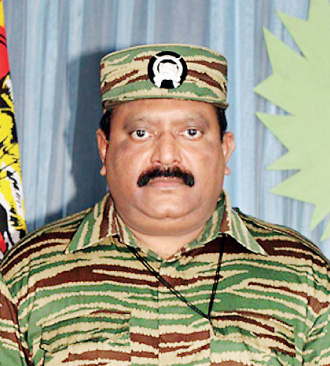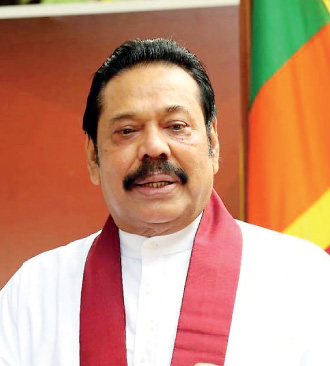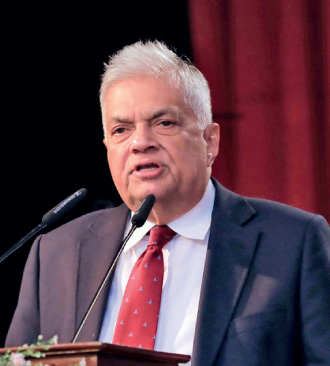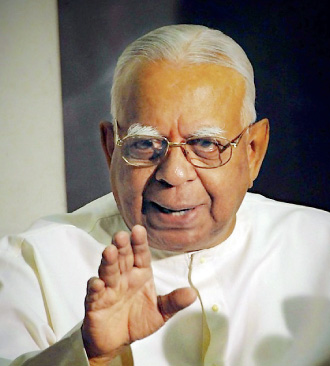Thursday Apr 24, 2025
Thursday Apr 24, 2025
Friday, 25 August 2023 02:41 - - {{hitsCtrl.values.hits}}

LTTE Head Velupillai Prabhakaran

Mahinda Rajapaksa

President Ranil Wickremesinghe

TNA Leader R. Sampanthan
|
 There has been in recent times a spurt of Ranil bashing in Sri Lankan Tamil circles. Many Tamil politicians as well as significant sections of the Tamil media are being highly critical of President Ranil Wickremesinghe these days. What fuels Tamil criticism of Ranil is his allegedly duplicitous conduct on the question of implementing the 13th Constitutional Amendment. He is being accused of not being sincere in this and is merely paying lip service. Some even allege unfairly that the President’s hidden agenda is to stultify the provincial councils in practice.
There has been in recent times a spurt of Ranil bashing in Sri Lankan Tamil circles. Many Tamil politicians as well as significant sections of the Tamil media are being highly critical of President Ranil Wickremesinghe these days. What fuels Tamil criticism of Ranil is his allegedly duplicitous conduct on the question of implementing the 13th Constitutional Amendment. He is being accused of not being sincere in this and is merely paying lip service. Some even allege unfairly that the President’s hidden agenda is to stultify the provincial councils in practice.
The irony in this is that President Wickremesinghe is being attacked by self-styled Sinhala ultra-nationalists over the same 13th Amendment issue. Only in this case Ranil is being accused of dancing to the Tamil tune and attempting to implement the 13th Amendment in full. This according to the Sinhala hawks will lead to the establishment of Tamil Eelam and negate the gains of the military victory over the Liberation Tigers of Tamil Eelam (LTTE). It appears that the adherents of “Gota Chintanaya” are trying to make a political comeback by thumping chauvinist drums again.
While Wickremesinghe is being condemned for betraying the Sinhala nation by persons claiming to be Sinhala patriots, the so called Tamil nationalists charge him of craftily undermining Tamil interests. Ranil is frequently described as a “Nariththanthirasaali (person with foxy cunning). It is stated that the former LTTE political adviser Anton Balasingham had referred to Ranil as a “Kullanari” or cunning fox in the past.
Ranil Wickremesinghe was compared to a fox by Balasingham in 2005 when the LTTE enforced a boycott of the 2005 Presidential elections by Tamil voters in areas controlled by it. This enforced boycott too is being referred to constantly in the current anti-Ranil campaign. It is being repeated ad nauseam that the “mighty” LTTE had correctly identified Wickremesinghe as being duplicitous and had therefore ensured his defeat at the 2005 Presidential elections.
The November 2005 Presidential poll was the last presidential election in which Ranil Wickremesinghe contested. He lost to Mahinda Rajapaksa in that tussle. This was mainly due to the LTTE’s enforced boycott. Why I keep referring to it as “enforced boycott” is because the Tamil people did not refrain from voting voluntarily. Most of them were forced to do so by the LTTE through the forcibly enforced boycott.
What happened in 2005 was that the LTTE and the Tamil National Alliance (TNA) together called openly for a boycott of the 2005 presidential poll in the predominantly Tamil areas. However the LTTE as was typical worked behind the scenes and enforced the boycott through violence and intimidation. Several lakhs of Tamil voters kept away or were kept away from the polling booths. In a fair and free election the bulk of these votes were likely to have been in favour of Ranil. As a result Wickremesinghe was deprived of around 250,000 to 300,000 Tamil votes.
Mahinda Rajapaksa
In the keenly contested 17 November 2005 Presidential elections, Mahinda Rajapaksa polled 4,887,152 (50.29%) votes while Ranil Wickremesinghe obtained 4,706,366 votes (48.43%). Ranil lost to Mahinda by 180,786 votes. Had the LTTE not enforced the boycott the result may have been one of Mahinda losing to Ranil. The voting pattern at the poll indicated that the majority of Tamil and Muslim votes had indeed been cast for Ranil. The LTTE had helped Mahinda win by bringing about Ranil’s defeat.
When the poll campaign was on, charges were levelled against Ranil about an “Ali-Koti” secret pact. It was alleged that the tiger organisation and the elephant party were involved in a conspiracy to make Wickremesinghe president. What actually happened at the presidential hustings in 2005 was almost the opposite of the allegations levelled against Ranil. The man accused of conspiring with the LTTE to win the poll became the victim of a Tiger conspiracy and lost. Thus in a bitterly cruel irony the man accused of conspiring with the LTTE to win the election was in reality defeated by the Tigers themselves.
Viewed against this backdrop it may be of interest to visit the not so distant past once again. Why and how did the LTTE and TNA in 2005 sabotage Ranil Wickremesinghe’s chances of victory and helped defeat the man who removed the LTTE proscription and was prepared to explore even federalism? What are the reasons that led to this ill-advised move by the Tigers which in the final analysis boomeranged on the two-legged felines themselves? How was the boycott that disenfranchised countless Tamil voters enforced by the LTTE? This two-part article will briefly re-examine the LTTE enforced boycott of the 2005 Presidential elections with the aid of earlier writings.
Enforced boycott
The 2005 LTTE enforced boycott was to demonstrate ostensibly to the world at large that the Tamil people were disillusioned by presidential candidates and had nothing to gain from a new president. The Tamils belonged to “Tamil Eelam” and were unconcerned about Sri Lanka was the message sought to be conveyed initially. Though the decision to be neutral and boycott polls was supposedly a people-based decision, it was obvious that the LTTE directed the events. It was also clear that the LTTE did not want one particular candidate namely Ranil Wickremesinghe to win. In effect the LTTE wanted the pro-peace Ranil to lose and not be elected as executive president. The Tigers wanted Mahinda Rajapaksa to win. The reasons for the LTTE stance were rather complex.
The LTTE had initially stated that it was neutral in the 2005 presidential stakes and would play no role in it. It said the Tamil people were free to exercise their franchise if they desired so or they could refrain from voting. The Tamil people were politically mature and would act appropriately the LTTE said.
As time went by the LTTE detected a groundswell of support among Tamil people for the United National Party (UNP) candidate Ranil Wickremesinghe. The LTTE then changed its stance slightly and began berating both Mahinda Rajapaksa and Ranil Wickremesinghe. Both had failed the Tamil people and were unworthy of Tamil support they said.
In spite of all this the visible trend was a rising tide of Tamil votes for Wickremesinghe. This spontaneous Tamil support for Ranil gathering momentum then was due to several reasons. Foremost among them was the perceived hawkish policies of Mahinda Rajapaksa and his pacts with the Janatha Vimukthi Peramuna (JVP) and Jathika Hela Urumaya (JHU). The Tamil people abhorring a return to war, felt quite rightly that a victory for Mahinda would hasten a resumption of armed hostilities.
There was also a feeling of gratitude for Wickremesinghe. It was he who de-proscribed the LTTE and entered into a ceasefire with the Tigers. Besides Ranil advocated negotiations with the LTTE and was in favour of exploring a federal solution. His economic policies were also attractive to Tamils.
It was also realised that Wickremesinghe depicted as a traitor to the Sinhala people by his opponents for his dovish policies faced the risk of losing Sinhala votes on account of this. The thinking sections of the community believed that it was therefore necessary for Tamils to vote for Wickremesinghe in large numbers to offset this disadvantage.
Minority-friendly candidate
The presidential poll was of crucial importance to all minority communities then. Mahinda Rajapaksa and his hard-line cohorts posed a grave threat to their interests. The need of the hour was for the minorities to rally firmly behind the comparatively minority-friendly candidate as a counterpoint to the perceived threat of a Sinhala Buddhist hard-line juggernaut threatening to crush them underfoot.
Many minority community parties like the Sri Lanka Muslim Congress, the Ceylon Workers Congress, Up Country People’s Front, Democratic People’s Front (then Western Province People’s Front) were all aligned with Wickremesinghe. Even the Catholic Bishops indicated indirect support. The stances adopted reflected the thinking of the minorities then. The Sri Lankan Tamils like the Muslims, Up Country Tamils and Catholics felt Wickremesinghe was the better of the two major candidates or from another perspective, the lesser evil.
The LTTE however was unhappy about this natural proclivity on the part of Tamils in particular and the minorities in general to support Wickremesinghe. Viewing the situation only from its narrow, sectarian perspective the LTTE preferred a Wickremesinghe defeat and a Rajapaksa victory in 2005.
There were many reasons for this perplexing approach. The most important one was that a hard-line government in Colombo was seen as more conducive to a possible outbreak of war. It was felt that international opinion would be firmly opposed to such a regime if and when a war erupted. This in turn was expected to be beneficial for the LTTE.
On the other hand the LTTE was resentful and suspicious about Wickremesinghe. It was worried about the overwhelming Tamil support for him. It did not want a replay of the 1994 scenario where Chandrika Kumaratunga came to power with tremendous Tamil support.
The Tigers were also insecure about Wickermesinghe’s international clout. The Tigers feared that in the event of war escalating, the world at large would support Colombo if Ranil was at the helm. It was felt that an amenably flexible president like Ranil would also reduce the scope for the LTTE to cite valid reasons for resuming the war against the State.
“Samaathaanap Pori” (peace trap)
There had been simmering dissent in Tiger circles for long that Wickremesinghe’s ceasefire was a calculated device to weaken and debilitate the LTTE in the long-run. It was described as a “Samaathaanap Pori” or peace trap by pro-Tiger opinion makers.
This LTTE stance to some extent was one where the perceived interests of the Tigers diverged from the real interests of the Tamil people. The ordinary Tamil people did not want war and so preferred the best possible candidate who they thought would avoid war and talk peace and power sharing with the LTTE.
Common sense and past experience decreed that Wickremesinghe was the better of the two in that respect. It did not matter whether Wickremesinghe could deliver or not. Given Rajapaksa’s standpoint and those of his allies, Wickremesinghe was certainly the better of the two from a general Tamil peace perspective. Actually supporting Ranil’s candidacy then was a case of Hobson’s choice for peace-loving Tamils abhorring war.
The LTTE however had a different perspective to that of the Tamils at large in 2005. For the militaristic Tigers, Mahinda Rajapaksa was the better option than Ranil Wickremesinghe. The interests of the LTTE took precedence over that of the welfare of the Tamil people. Wickremesinghe was more dangerous in a war situation as opposed to Rajapaksa.
While sections of the Sinhala electorate thought that a southern veeraya like Rajapaksa was sending shivers down the Tiger spine, the reality at the 2005 presidential poll was different. Though Ranil was decried by his adversaries as a weak traitor, it was a victory for Wickremesinghe that posed a grave threat in the LTTE perception. Given a direct choice the Tigers preferred Rajapaksa to Wickremesinghe.
Ironic contradiction
This led to an ironic contradiction. The Tamil people wanted a president to talk peace with the Tigers and prevent war while the Tigers wanted a president who could disrupt peace and bring about war. In such a situation the franchise of the people became a casualty. This was the crux of the matter in 2005.
Against that backdrop the LTTE found that despite their covert signals the Tamil people were planning to support Wickremesinghe overwhelmingly. This then led to a situation where the Tigers were forced to target Wickremesinghe more directly. Senior leader K.V. Balakumaran openly attacked Wickremesinghe and made it clear that he was the more “dangerous” of the two. Political Commissar S.P. Thamilselvan followed suit. The Tiger and pro-Tiger media launched an intensive offensive against Ranil. The UNP was described as more dangerous than the SLFP. The SLFP was a “seerikkadikkum naaham” (hissing cobra which gave warning before it bit). The UNP was a “seeraamal kadikkum pidaiyan” (the viper which stung silently without giving warning).
A parallel exercise undertaken indirectly was an orchestrated campaign urging Tamils to desist from voting. Since the international community was observant and the Norway facilitated ceasefire was in progress, the LTTE did not call openly for an election boycott in the initial stages. Instead a number of front organisations notably student outfits, took up the cry.
Still the detectable tendency as far as the Tamil people were concerned was to vote and to vote for Ranil. This was due to a realisation based on common sense that Wickremesinghe had to be supported to prevent anticipated Sinhala Buddhist hegemony and consequent war.
Whatever the LTTE desired, the ordinary Tamils grasped shrewdly that it was in their best interests to back Wickremesinghe. It was not as if Ranil was a positive choice. But compared to Mahinda, the Tamil people preferred Wickremesinghe.
|
Rajavarothayam Sampanthan
So the Tigers had to raise the ante further. They were compelled to convene a news conference on 10 November 2005 after a joint meeting with their obedient servant, the Tamil National Alliance. It was announced by TNA leader Rajavarothayam Sampanthan that the “people” had decided to boycott polls. The LTTE-TNA were simply expressing “their” wishes.
“Tamil residents in North-East are fully aware of the conduct of the two major Sinhala parties. They have been through and suffered through periods under these parties’ governance. We know and understand Tamil peoples’ frame of mind. We have no doubt that they are in full agreement with our thinking,” Rajavarothayam Sampanthan told the media then.
“We discussed in depth and exchanged our views on the situation related to the elections and what historical significance our participation in the elections is going to be for the future of our people,” he said.
“There was no doubt in any of the participants’ mind that the Presidential election will not produce any positive shift in the Southern Polity’s thinking and approach that will in anyway result in any progressive advance towards resolving the Tamil question. That is why we decided that it is a futile exercise to show any interest in the elections,” Sampanthan told the media at that time.
In spite of the attempt to depict it as a people’s boycott, Sampanthan gave the game away when he said that, “the people were in agreement with OUR thinking.” It was clear that the decision to boycott was not a groundswell reflecting the wishes of the people but one being imposed from above by the LTTE on the Tamil people to which the TNA played second fiddle.
Despite these moves the Tigers had to officially maintain a position of ‘detachment.’ The fiction that the people were going to boycott was publicised to a great extent. It was necessary to pay lip service to the notion that the Tamil people were free to decide whether they wanted to vote or not. “The Tamil people would choose wisely” was hinted at heavily. Unfortunately for the LTTE, the Tamil people were still of the opinion that they should vote in large numbers for Wickremesinghe.
With rival groups like the Eelam People’s Democratic Party (EPDP) and the LTTE breakaway Karuna faction urging and encouraging a large Tamil voter turnout, it was becoming a matter of prestige for the LTTE. The anti-LTTE comments made then by Navin Dissanayake at a meeting in Ginigathena and Milinda Moragoda in a newspaper interview caused further complications. It was now becoming necessary to enforce a boycott and deprive Wickremesinghe of victory. Ranil and the UNP had to be taught an unforgettable lesson was the Tiger line of thinking.
Boycott call
It was now out in the open and the Tiger hand behind the boycott call was becoming exposed. A call to declare election day, a day of mourning and for people to stay indoors was made through a student front. Even public servants on election duty were asked to stay at home.
The pro-Mahinda elements had earlier been accusing Wickremesinghe of a tie-up with the LTTE and charging that the Tigers were going to deliver the Tamil vote en bloc to Ranil. Now they changed track and began gloating over the fact that the Tigers were now trying to sabotage Wickremesinghe. It was comical indeed to see people reverse their stances overnight and in the process expose the venom they had against Ranil Wickremesinghe.
Wickremesinghe’s well-wishers and sections of the international community were aghast. Many lines of communication were opened with the LTTE. Several international community representatives and local politicians appealed to the LTTE. Representations were made to Anton Balasingham in London. Former Up Country People’s Front Leader Periyasamy Chandrasekeran went to Kilinochchi as Ranil’s emissary. After meeting Thamilselvan he returned to Vavuniya and spoke on the telephone with Wickremesinghe. He then went to Kilinochchi again to meet the LTTE political commissar. Some TNA parliamentarians also took up Wickremesinghe’s case.
As a result of these efforts the LTTE hierarchy in Kilinochchi gave an assurance that the Tigers would not strictly enforce a boycott. They would merely call for a boycott but not adopt any further action to actually instil a boycott. They would leave the matter entirely to the people. They would not stand in the way of voters wishing to exercise their franchise.
LTTE doublespeak
This was unadulterated LTTE doublespeak but the UNP chose to believe it then. I recall telling former “Sunday Leader” editor Lasantha Wickrematunge not to be deceived by the Tigers. He dismissed my warning lightly but later realised I was correct and was apologetic when the LTTE enforced its boycott subsequently. The details of how the boycott was enforced and its outcome will be related in the second and final part of this article.
(The writer can be reached at [email protected].)
Discover Kapruka, the leading online shopping platform in Sri Lanka, where you can conveniently send Gifts and Flowers to your loved ones for any event including Valentine ’s Day. Explore a wide range of popular Shopping Categories on Kapruka, including Toys, Groceries, Electronics, Birthday Cakes, Fruits, Chocolates, Flower Bouquets, Clothing, Watches, Lingerie, Gift Sets and Jewellery. Also if you’re interested in selling with Kapruka, Partner Central by Kapruka is the best solution to start with. Moreover, through Kapruka Global Shop, you can also enjoy the convenience of purchasing products from renowned platforms like Amazon and eBay and have them delivered to Sri Lanka.
Discover Kapruka, the leading online shopping platform in Sri Lanka, where you can conveniently send Gifts and Flowers to your loved ones for any event including Valentine ’s Day. Explore a wide range of popular Shopping Categories on Kapruka, including Toys, Groceries, Electronics, Birthday Cakes, Fruits, Chocolates, Flower Bouquets, Clothing, Watches, Lingerie, Gift Sets and Jewellery. Also if you’re interested in selling with Kapruka, Partner Central by Kapruka is the best solution to start with. Moreover, through Kapruka Global Shop, you can also enjoy the convenience of purchasing products from renowned platforms like Amazon and eBay and have them delivered to Sri Lanka.